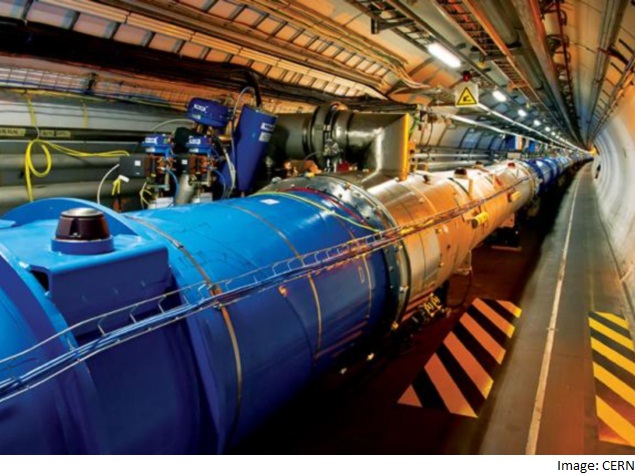- Home
- Science
- Science News
- New Blow for 'Supersymmetry' Physics Theory
New Blow for 'Supersymmetry' Physics Theory

In a new blow for the futuristic "supersymmetry" theory of the universe's basic anatomy, experts reported fresh evidence Monday of subatomic activity consistent with the mainstream Standard Model of particle physics.
New data from ultra high-speed proton collisions at Europe's Large Hadron Collider (LHC) showed an exotic particle dubbed the "beauty quark" behaves as predicted by the Standard Model, said a paper in the journal Nature Physics.
Previous attempts at measuring the beauty quark's rare transformation into a so-called "up quark" had yielded conflicting results. That prompted scientists to propose an explanation beyond the Standard Model possibly supersymmetry.
But the latest observations were "entirely consistent with the Standard Model and removes the need for this hypothesis" of an alternative theory, Guy Wilkinson, leader of LHC's "beauty experiment" told AFP.
"It would of course have been very exciting if we could show that there was something wrong with the Standard Model I cannot deny that would have been sensational," he said.
The Standard Model is the mainstream theory of all the fundamental particles that make up matter, and the forces that govern them.
But the model has weaknesses: it doesn't explain dark matter or dark energy, which jointly make up 95 percent of the universe. Nor is it compatible with Einstein's theory of general relativity the force of gravity as we know it does not seem to work at the subatomic quantum scale.
Supersymmetry, SUSY for short, is one of the alternatives proposed for explaining these inconsistencies, postulating the existence of a heavier "sibling" for every particle in the universe.
This may also explain dark matter and dark energy.
'Many-headed monster'
But no proof of supersymmetric twins has been found at the LHC, which has observed all the particles postulated by the Standard Model including the long-sought Higgs boson, which confers mass to matter.
Supersymmetry predicts the existence of at least five types of Higgs boson, but only one, believed to be the Standard Model Higgs, has so far been found.
Wilkinson said it was "too soon" to write off supersymmetry.
"It is very difficult to kill supersymmetry: it is a many-headed monster," he said.
But "if nothing is seen in the next couple of years, supersymmetry would be in a much harder situation. The number of true believers would drop."
Quarks are the most basic particles, building blocks of protons and neutrons, which in turn are found in atoms.
There are six types of quarks the most common are the "up" and "down" quarks, while the others are called "charm", "strange", "beauty" and "top."
The beauty quark, heavier than up and down quarks, can shift shape, and usually takes the form of a charm quark when it does.
Much more rarely, it morphs into an up quark. Wilkinson's team have now measured for the first time how often that happens.
"We are delighted because it is the sort of measurement nobody thought was possible at the LHC," he said. It had been thought that an even more powerful machine would be needed.
The revamped LHC, a facility of the European Organisation for Nuclear Research (CERN), was restarted in April after a two-year revamp to boost its power from eight to 13, potentially 14, teraelectronvolts (TeV).
"If you expect Earth-shattering news from the new run, it's a bit early," CERN director-general Rolf Heuer told journalists in Vienna Monday at a conference of the European Physical Society.
"The main harvest will come in the years to come, so you have to stay tuned."
So far, the new run at 13 TeV has re-detected all the Standard Model particles except for the Higgs boson, but Heuer insisted: "We are sure that it is there."
Catch the latest from the Consumer Electronics Show on Gadgets 360, at our CES 2026 hub.
Related Stories
- Samsung Galaxy Unpacked 2025
- ChatGPT
- Redmi Note 14 Pro+
- iPhone 16
- Apple Vision Pro
- Oneplus 12
- OnePlus Nord CE 3 Lite 5G
- iPhone 13
- Xiaomi 14 Pro
- Oppo Find N3
- Tecno Spark Go (2023)
- Realme V30
- Best Phones Under 25000
- Samsung Galaxy S24 Series
- Cryptocurrency
- iQoo 12
- Samsung Galaxy S24 Ultra
- Giottus
- Samsung Galaxy Z Flip 5
- Apple 'Scary Fast'
- Housefull 5
- GoPro Hero 12 Black Review
- Invincible Season 2
- JioGlass
- HD Ready TV
- Laptop Under 50000
- Smartwatch Under 10000
- Latest Mobile Phones
- Compare Phones
- OPPO Reno 15 Pro Max
- Honor Win RT
- Honor Win
- Xiaomi 17 Ultra Leica Edition
- Xiaomi 17 Ultra
- Huawei Nova 15
- Huawei Nova 15 Pro
- Huawei Nova 15 Ultra
- Asus ProArt P16
- MacBook Pro 14-inch (M5, 2025)
- OPPO Pad Air 5
- Huawei MatePad 11.5 (2026)
- Xiaomi Watch 5
- Huawei Watch 10th Anniversary Edition
- Acerpure Nitro Z Series 100-inch QLED TV
- Samsung 43 Inch LED Ultra HD (4K) Smart TV (UA43UE81AFULXL)
- Asus ROG Ally
- Nintendo Switch Lite
- Haier 1.6 Ton 5 Star Inverter Split AC (HSU19G-MZAID5BN-INV)
- Haier 1.6 Ton 5 Star Inverter Split AC (HSU19G-MZAIM5BN-INV)

















